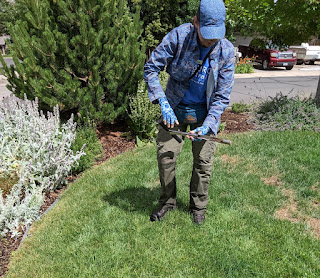 |
| Photo: Peggychouair Pixabay |
We signed up for the Slow the Flow free sprinkler evaluation
and were pleasantly surprised at what we got. Their technician spent a full
hour at our property checking our controller and watering schedule, provided
tune-up recommendations and much, much more. And to top it off, because we used
the evaluation, we qualified for a free wireless Rachio 3 smart sprinkler controller and
a free Rainbird wireless rain sensor!
 |
| Old Controller Box Photo by Nancy Shepard |
She first spent time with our sprinkler control box telling us that these are very old boxes, but many still do a good job. Unfortunately she told us our model is notorious for wiring issues (we had already noticed this.) Our watering schedule was right on the mark using the cycle and soak method in which we run each lawn zone for only 4 minutes at a time but spread it out 3 times over 3 hours (for a total of 12 minutes for each lawn zone.) See below for more about the cycle and soak method. With watering just 3 days per week, with 2 lawn zones and 2 drip zones, we still met the criteria for watering frequency in hot mid summers. She reset our controller from watering 165 minutes per week to 156 minutes a week, a savings of 5% - hey, every little bit counts.
Spray Heads
Next she turned on each zone to look at the sprayers and their angles. Here is where we got our big “ah ha” moment. Turns out
that our spray-type heads are designed to water each other, not the area around the head. That’s why we had dryer
grass close to each sprayer head. She said the heads tell each other “you water
me and I’ll water you.” Also some of our heads were tilted, some blocked by
foliage and others not using the correct angle (180 vs. 145 degree coverage.)
 |
| Measuring water pressure. Photo by Nancy Shepard |
Water Pressure
She moved on to check the water pressure coming to the
sprinkler system. Ours was 48 psi, on the high side as the recommended pressure
is 30 psi. With this 48 psi we are more prone to misting or fogging. We might
consider a pressure regulator to the main line.
 |
| Measuring distribution uniformity. Photo by Nancy Shepard |
Next she moved on to look at the sprayers’ coverage or
what they call “distribution uniformity” or DU. She placed special cups over the lawn and ran the zone for about 5 minutes. Each cup has inch marks on
the side which she checked and recorded. Our DU came out at 61% which she told us
was better than many homeowners where she sees numbers around 40%. For example,
100% DU means that all the water being applied to your lawn is being applied
evenly across the surface. Anything less than 100% would mean that some areas
of your lawn are receiving less water than the rest. So we still fell into the “good”
category but could be doing better.
 |
| Taking lawn core samples. Photo by Nancy Shepard |
Soil Core Samples
She then did several core samples of our lawn showing the soil type and depth of the roots. Ours showed clay soil (of course) and 3 inches of lawn root which she said was decent.
Final Report
The final report we received showed the old controller
schedule and the new one programmed by the technician. The report also
identified the issues with our system in each zone including low sprinkler
heads, overspray, blocked and tilted sprinkler heads. We had also asked the
technician about replacing our standard spray nozzles with high efficiency
nozzles. Based on the layout of our zones and because our two lawn zones are
relatively small, she only recommended the replacement for our front lawn zone which
is surrounded by perennial beds on all sides. Turns out these nozzles have a
much lower precipitation rate than our current nozzles so we would have to
triple or quadruple the run time for zones that use those nozzles. And these
high efficiency nozzles spray much farther and for small lawns you end up
watering sidewalks and areas with no vegetation.
The Slow the Flow program partners with several cities in the Denver Metro area who are motivated to help home owners reduce their water consumption, paying for the new digital controllers. Ours was Westminster, one of 30 cities they include. To see if you qualify and to see their other programs, see:
For more about the cycle and soak method of watering see:



